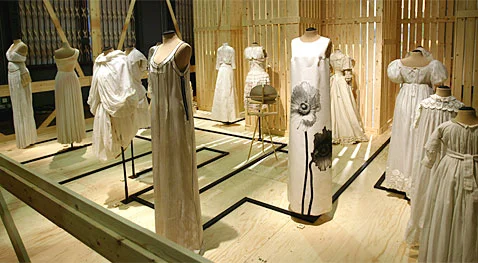When you hear experimental, Fashion and Oscar Wilde cited in the same conversation you may hardly believe you are in Miami. If symptoms persists, you pinch yourself and the rest is history.
So it happened.
Image from The Fashion Project
WHO Judith Clark, Curator and Exhibitor Maker; Adam Phillips, Psychoanalist and Paul Holdengraber master interviewer of LIVE from the NY Public Library as moderator.
WHAT The Fashion Project, a series of experimental exhibitions orchestrated by Judith Clark and installed in a dedictaed space on the third floor of Bal Harbour.
WHERE Books & Books in Bal Harbour
WHEN Friday April 10th
WHY the opening of the first of a series of six.
The exhibition is a celebration of fashion in all its caleidoscopic aspects and under a 'multidisciplinary lens'. Fashion pieces, ranging from an original Schiaparelli to a futuristic wired Hussein Chalayan, are showcased in Victorian cabinets with no chronological order. Concept is 'objects are staged with non predictable impact', they give you enough to awaken a memory, evoke a connection, allure you into a dreamy state, resonate and stimulate the cultural forces from which they emerged, create an aura of wonder around the uniqueness of the piece.
Following a random extract of what was said.
Image from The Fashion Project
Fashion, with the F, is to be taken seriously, it is not trivial to talk about clothes.
Everyone in the room thought of giving them a big hug. Adam Phillips went ahead to declare that 'it's a shame that vanity has a pejorative connotation.' Again: thank you.
~~
“Only shallow people do not judge by appearances”
~~
We are assisting to a rehab of clothing and we must underline the seriousness of Fashion.
~~
Clothing represents our daily life, dresses are a meter to decipher the everyday. The reason to keep clothing through years and generations is to see what you can make out of it. Dresses have a life with the body inside and without.
I always admited that with me it all started in my grand-mother's armoire.
~~
"Museums make me sad" Paul Holdergraber said that James Boom said, because they represent fragments harvested from the past and categorize them, it is like extracting their essence and leaving them to the wind of the moment. Judith Clark elaborated that yes somehow with dresses there's that immediate sense of loss because the body is not there. What do you do with a dress when the owner is not alive anymore? She adds that she leaves the viewer decide what meaning to give to that dress in that cabinet in the open space of the exhibition.
I would wear it.
~~
'We are dressed before we dress.' Truer than true Aren't we all dressed by our mothers before we are then given the initiative to dress alone? And even then, our style is either a by-product or a rebellion to our mothers' minds, closets. (I remember the first thing that I swore I wasn't going to wear anymore "when I grow up" was the Scottish kilt with the safety pin to close it, as a form of internal revolution against the institutionalized power of my mother's conservative way of dressing).
~~
Clothes are a foundamental way of expression.
Again, no frivolity here.
~~
Clothes designers are historians.
We just saw it here with the return of the Seventies: they have this superior sensibility of feeling a moment, getting inspired by an era, remembering a period of their youth or something that their monther or grandmother used to wear and with the power of imagination and sense of esthetic recreate it for the woman of today.
~~
Dresses and your personal style are a language as powerful as words.
Adam Phillips confessed that he took clothes for granted before knowing Judith Clark.
All I can say is thumbs up #girlpower to Judith: thanks for awakening that whole world in front of him and thank you for making this initiative happen in Miami.
Thanks Paul Holdengraber for baing a gracious and curious moderator.


